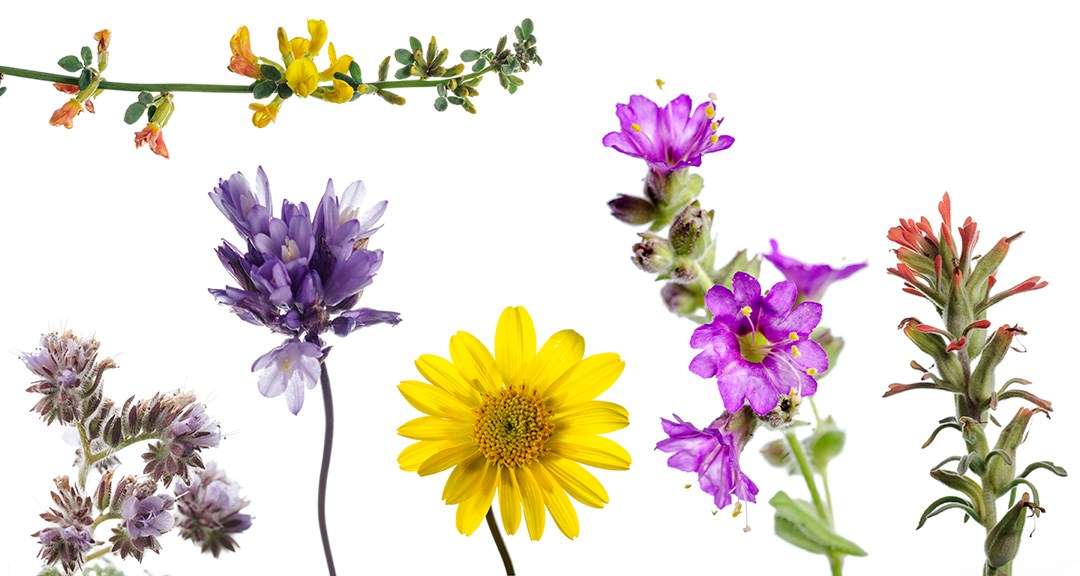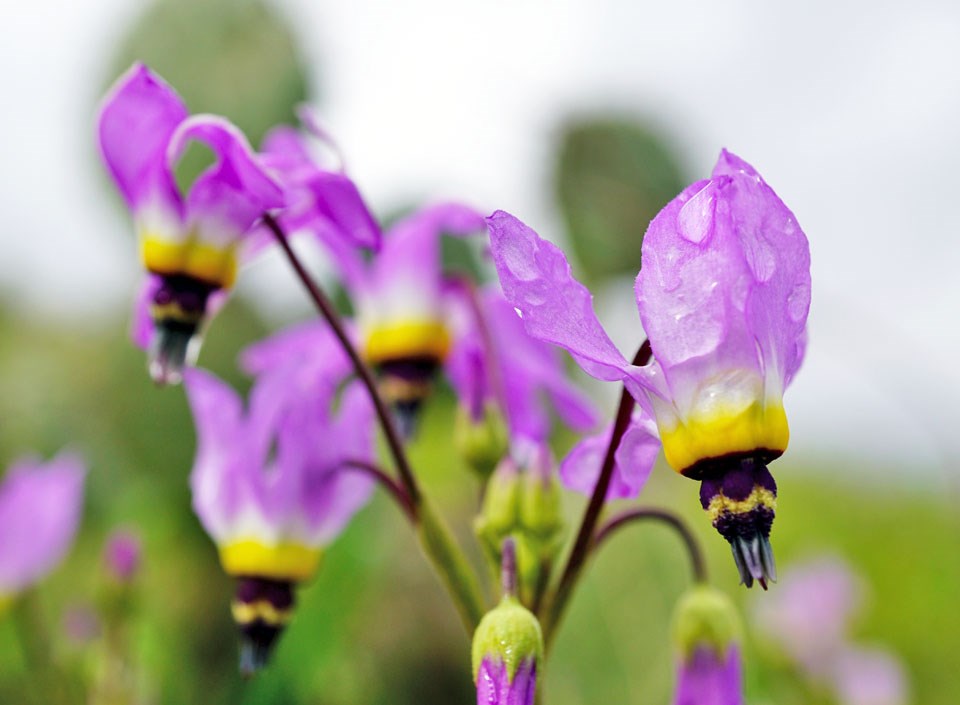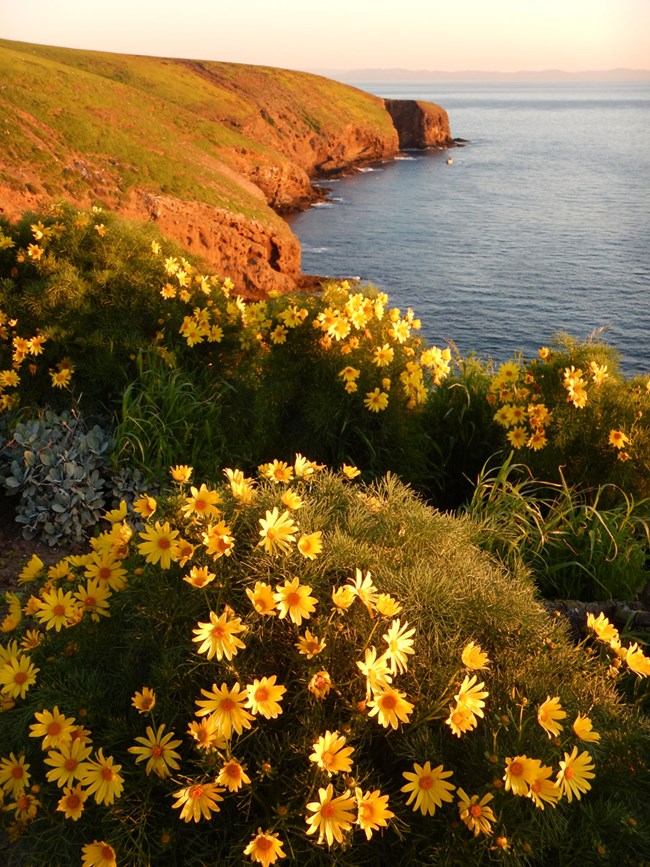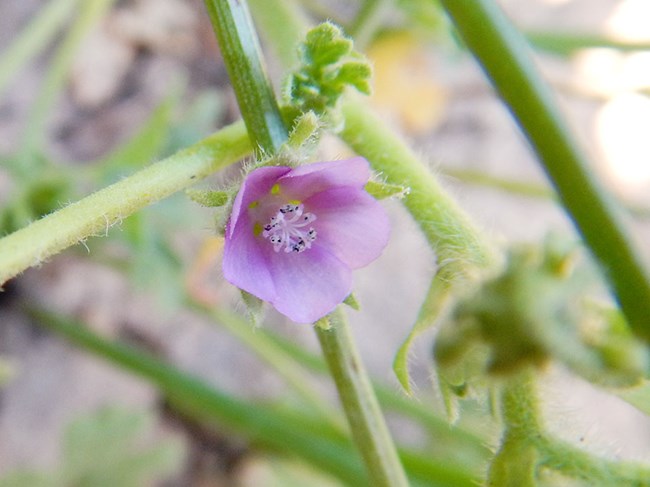Last updated: March 21, 2017
Article
Field Season Beginning for Mediterranean Coast Plant Monitoring Teams
Cabrillo National Monument
The Mediterranean ecosystem at Cabrillo National Monument is dominated by coastal sage scrub and maritime chaparral plant communities, which have adapted to warm, dry summers and cool, wet winters. On average San Diego receives 10.4 inches of precipitation a year. Drought conditions in recent years have brought only about half of that amount. Perennial native shrubs tend to persist through dry years by limiting growth and putting out minimal flowers and seeds. Annual native wildflowers, whose seeds can remain dormant for years, tend to germinate and bloom in abundance only in those years when precipitation is plentiful.

Michael Ready / Cabrillo National Monument Artist in Residence, 2015
This season, we are excited to explore and document the botanical diversity of the park. With current precipitation totals at 150 percent of normal, the we are expecting a great flower season from March to early May. Our annual vegetation monitoring will be conducted during peak bloom, which is typically between late March and early April.
- Keith Lombardo, Chief of Natural Resource Management and Science
Santa Monica Mountains National Recreation Area
The peak bloom window at Santa Monica Mountains National Recreation Area tends to be a bit wider than at Cabrillo. The reason lies in the park being larger east to west (ocean to inland) and in terms of elevation. The blooms tend to begin on the coastal slopes before progressing inland and upward. Even so, we now monitor 100 upland vegetation plots over the course of the season, so not all can be surveyed during peak flowering. We try to survey the plots with most herbaceous diversity during the peak season. Earlier in the season we target plots in denser chaparral with heavy leaf litter where we generally haven't found very many forbs. In general, monitoring in the park begins in March and continues into June.

NPS
Because of the four back to back dry years, we have seen a lot of dieback. Now that Ceanothus species are flowering, the numerous grey bushes scattered, sometimes in extensive stands, stand out easily among the flowering shurbs. While the overstory has died back, openings have been created where a lot of herbaceous seedlings have now sprung up following the recent rains. We look forward to a fine wildflower year, while trying not to put our hopes too high until the countless seedlings actually flower. What could go wrong? A sudden freeze, surprise heatwave, or high drying winds could always come along and spoil the show. For a botanist, the unpredictability of unfolding spring is a euphoric mix of agony and exhilaration.
It is not easy to predict a single best time to get out and witness the euphoria of spring for yourself in the Santa Monica Mountains. Different species show off their own spectacular blooms at different times. Those who make it out on the trail and into the backcountry more than once as the season unfolds typically see the most species. Still, if the season goes well, almost any hike is likely to result in a rewarding wildflower experience.
- Tarja Sagar, Botanist
Channel Islands National Park

NPS / Dirk Rodriguez
For the Channel Islands National Park botany department, the field season usually starts in February after the winter rains have had a chance to work their magic on the island’s flora. Things really get underway, for the most part, with the first trip to Santa Barbara Island. This is the southernmost island in the park, and one of the least visited. After a stop at East Anacapa Island to drop off other staff, the park boat is off to Santa Barbara, which comes into view after a sometimes rolling 2 ½ hour ride. This year we botanists must skiff to the island. The landing dock is damaged from winter storms last year and closed to the public. Fortunately the crane still works to haul up our gear from the boat.
From there, two weeks of gear must be hauled up the narrow steps to the housing quarters, now crowded by a beautiful giant coreopsis that has rebounded with a vengeance over the winter. Those who have worked on the island more than once know it is worth their while to pack light. Only after all the gear is finally carried up can we take stock of this year’s Santa Barbara Island plant life.
The vegetation transects that we monitor each year are scattered throughout the island from east to west and north to south. Every year there are subtle or not-so-subtle changes that have been wrought by sun, time, and rain (or the lack thereof). The last four years of drought had taken its toll on the Island’s flora, but this year it has rebounded with color and the song of the hornlark. The landscape is splashed in patches of bright yellow where the native giant coreopsis is in full bloom. Heads of wild hyacinth bob among the grasses in the sometimes strong, sometimes gentle breeze. The diminutive island poppy is scattered about amongst the cactus in drier parts of the island.

NPS / Dirk Rodriguez
A new plant has appeared as well. It is not large, and the flower does not immediately catch your eye, but a closer examination reveals its rosy petals peeking out. We couldn’t tell what it was at first, but eventually it gave us enough clues to determine its family. It is from the Malvaceae, home to showier cousins like hibiscus, holly hock, and Fremontodendron. From there we tracked it to the genus Eremalche, the desert mallows. This is a small group of native annual plants known only from the Southwest including California. Then one day another clue, it is most likely Eremalche exilis, or white mallow. It was recorded as being on Santa Cruz Island in 1888, and on Catalina Island in 1901, but hasn’t been seen on the Channel Islands since. Many think it is has been lost from those islands, but now nature has handed us a pleasant surprise and new hope.
With one week of vegetation monitoring down on this small pacific island, there is one more to go. And then, northward and westward! Surveys will continue at Anacapa Island, followed by Santa Cruz, Santa Rosa, and finally San Miguel Islands. It will be June or July before the season’s work is through.
- Dirk Rodriguez, Botanist
Prepared by the Mediterranean Coast Inventory and Monitoring Network.
